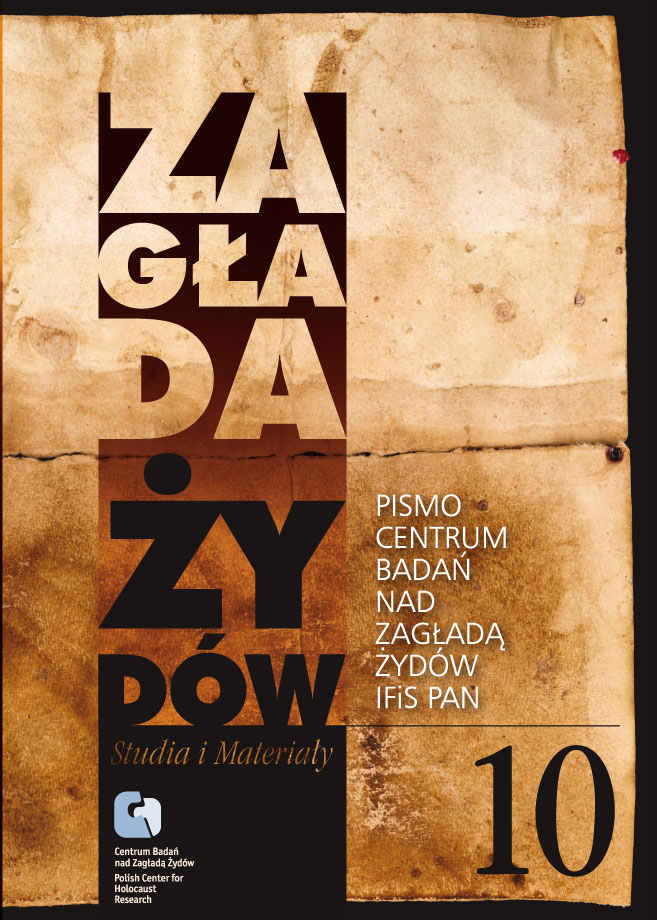Krzesiny i Kreising – między pamiętaniem a pomijaniem. Polskie miasteczko wobec historii, pamięci i rywalizacji w cierpieniu
Zagłada Żydów. Studia i Materiały, Nr 10 (2014), Strony: 443-461
Data zgłoszenia: 2020-10-22Data publikacji: 2014-12-01
 https://doi.org/10.32927/ZZSiM.532
https://doi.org/10.32927/ZZSiM.532
Abstrakt
The area around Krzesiny, located near the city of Poznań, Poland, witnessed several dark events during World War II: Germans oppressed the local population, culminating in a terrorizing action dubbed “akcja krzesińska;” also, a forced labor camp, named “Kreising,” was built near the township, housing mainly Jews. After the war, the suffering in Krzesiny was remembered, but selectively – “akcja” and other forms of Polish suffering were commemorated, while the camp was not. By exploring the “lieux de mémoire” in Krzesiny – dynamics of memory in a small township in Poland – this paper uses localized research to address the issue of gaps in collective memory and commemoration. We briefly look at the relevant history, Polish memory regarding wartime events in Krzesiny, and the postwar dynamics of collective memory. Discussing the latter, we identify a new phenomenon at work, one which we dub “collective disregard” – group neglect of the past of the “Other” that occurs without clear intent. We argue that “collective disregard” is an issue that naturally occurs in the dynamics of memory. By making a deliberate investment in balanced remembrance and commemoration, societies can counter the tendencies of “disregard” and curb the controversies of competitive victimization claims, also called “competitive martyrdom”.
Licencja
Prawa autorskie (c) 2014 Autor&"Zagłada Żydów. Studia i Materiały"

Utwór dostępny jest na licencji Creative Commons Uznanie autorstwa 4.0 Międzynarodowe.
https://creativecommons.org/licenses/by/4.0
Czasopismo publikowane jest w standardzie Diamond Open Access na licencji CC-BY-4.0 Deed - Uznanie autorstwa 4.0 Międzynarodowa - Creative Commons
Podobne artykuły
- Anna Szwarc-Zając , Willy, przyjaciel prawdziwy czy wymyślony? Rozważania nad polskim i włoskim tłumaczeniem książki Szukajcie w popiołach , Zagłada Żydów. Studia i Materiały: Nr 8 (2012)
- Jacek Leociak, Literatura dokumentu osobistego jako źródło do badań nad Zagładą Żydów (Rekonesans metodologiczny) , Zagłada Żydów. Studia i Materiały: Nr 1 (2005)
- Nawojka Cieślińska-Lobkowicz, Śladami nieznanych przedwojennych żydowskich kolekcjonerów i właścicieli dzieł sztuki , Zagłada Żydów. Studia i Materiały: Nr 17 (2021)
- Witold Mędykowski, The Jews are Coming Back: The Return of the Jews to their countries of origin after WW II, edited by David Bankier , Zagłada Żydów. Studia i Materiały: Nr 1 (2005)
- Martin Dean, Gospodarka wyzysku: „warunki życia” w gettach na kresach wschodnich , Zagłada Żydów. Studia i Materiały: Nr 3 (2007)
- Stanisław Krajewski, Mówienie o Zagładzie we współczesnej Polsce , Zagłada Żydów. Studia i Materiały: Nr 5 (2009)
- Redakcja Czasopisma, Feliks Tych in memoriam , Zagłada Żydów. Studia i Materiały: Nr 11 (2015)
- Grzegorz Berendt, Cena życia ─ ekonomiczne uwarunkowania egzystencji Żydów po "aryjskiej stronie" , Zagłada Żydów. Studia i Materiały: Nr 4 (2008)
- Caroline Sturdy Colls, O tym, co minęło, lecz nie zostało zapomniane: Badania archeologiczne na terenie byłego obozu zagłady w Treblince , Zagłada Żydów. Studia i Materiały: Nr 8 (2012)
- Victoria Van Orden Martínez, Emocje jako świadectwo. Aspekt psychologiczny składania przez ocalałych relacji przed komisją historyczną tuż po wojnie , Zagłada Żydów. Studia i Materiały: Nr 20 (2024)
<< < 1 2 3 4 5 6 7 8 9 10 11 12 13 14 15 16 17 18 19 20 21 22 23 24 25 26 27 28 29 30 31 32 33 34 > >>
Możesz również Rozpocznij zaawansowane wyszukiwanie podobieństw dla tego artykułu.
 English
English
 Język Polski
Język Polski




